Yesterday I watched a very interesting presentation by Tim Redmond courtesy of Murthy video talks entitled ‘The faces behind the clock’. It was a really unique opportunity to hear the history of and see inside one of the 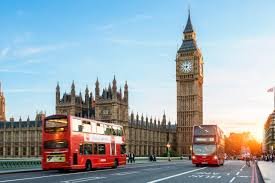 world’s most iconic buildings which most people refer to as Big Ben, but which is actually the Elizabeth Tower at the northern end of the Houses of Parliament. I have never taken the opportunity to tour the inside of the Houses of Parliament or the Elizabeth Tower so this talk was a welcome opportunity to learn about the latter from the comfort of my armchair.
world’s most iconic buildings which most people refer to as Big Ben, but which is actually the Elizabeth Tower at the northern end of the Houses of Parliament. I have never taken the opportunity to tour the inside of the Houses of Parliament or the Elizabeth Tower so this talk was a welcome opportunity to learn about the latter from the comfort of my armchair.
 world’s most iconic buildings which most people refer to as Big Ben, but which is actually the Elizabeth Tower at the northern end of the Houses of Parliament. I have never taken the opportunity to tour the inside of the Houses of Parliament or the Elizabeth Tower so this talk was a welcome opportunity to learn about the latter from the comfort of my armchair.
world’s most iconic buildings which most people refer to as Big Ben, but which is actually the Elizabeth Tower at the northern end of the Houses of Parliament. I have never taken the opportunity to tour the inside of the Houses of Parliament or the Elizabeth Tower so this talk was a welcome opportunity to learn about the latter from the comfort of my armchair.Before taking us inside the tower, Tim explained that in 1834, the Palace of Westminster was almost completely destroyed by fire so a replacement was required. A public competition was held inviting architects to submit designs for a new Palace and the winning drawing was by Charles Barry. Although Barry was the chief architect, 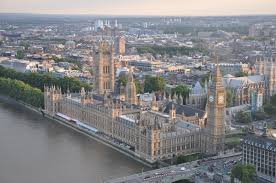 he collaborated closely with Augustus Pugin who not only advised him on the decorative details for the new Palace of Westminster but also suggested he include an impressive neo-gothic clock tower. In 2012, that Clock Tower was renamed the Elizabeth Tower in honour of the Queen’s Diamond Jubilee but it is still better known as Big Ben.
he collaborated closely with Augustus Pugin who not only advised him on the decorative details for the new Palace of Westminster but also suggested he include an impressive neo-gothic clock tower. In 2012, that Clock Tower was renamed the Elizabeth Tower in honour of the Queen’s Diamond Jubilee but it is still better known as Big Ben.
 he collaborated closely with Augustus Pugin who not only advised him on the decorative details for the new Palace of Westminster but also suggested he include an impressive neo-gothic clock tower. In 2012, that Clock Tower was renamed the Elizabeth Tower in honour of the Queen’s Diamond Jubilee but it is still better known as Big Ben.
he collaborated closely with Augustus Pugin who not only advised him on the decorative details for the new Palace of Westminster but also suggested he include an impressive neo-gothic clock tower. In 2012, that Clock Tower was renamed the Elizabeth Tower in honour of the Queen’s Diamond Jubilee but it is still better known as Big Ben.Using a selection of Tim’s photographs, we entered the building and looked up to see a stunning spiral staircase consisting of 334 steps.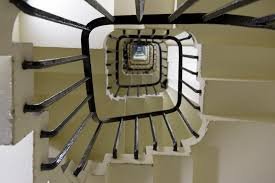 As we hypothetically climbed the stairs, every so often we would come across a door which we were allowed to open; as we entered the first one, we found ourselves standing behind the famous clock faces, each one of which is 23ft in diameter and composed of 312 pieces of opal glass set in a cast iron frame.
As we hypothetically climbed the stairs, every so often we would come across a door which we were allowed to open; as we entered the first one, we found ourselves standing behind the famous clock faces, each one of which is 23ft in diameter and composed of 312 pieces of opal glass set in a cast iron frame. 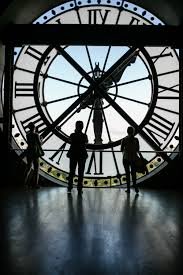 The hour hand is a mere 9.2ft long compared to each minute hand which is 14ft long. The clock faces have recently had a colour swap from black to blue in keeping with their original design and are illuminated by 28 energy-efficient bulbs.
The hour hand is a mere 9.2ft long compared to each minute hand which is 14ft long. The clock faces have recently had a colour swap from black to blue in keeping with their original design and are illuminated by 28 energy-efficient bulbs.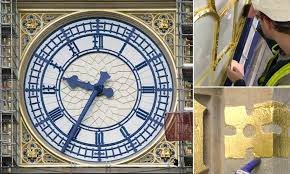
 As we hypothetically climbed the stairs, every so often we would come across a door which we were allowed to open; as we entered the first one, we found ourselves standing behind the famous clock faces, each one of which is 23ft in diameter and composed of 312 pieces of opal glass set in a cast iron frame.
As we hypothetically climbed the stairs, every so often we would come across a door which we were allowed to open; as we entered the first one, we found ourselves standing behind the famous clock faces, each one of which is 23ft in diameter and composed of 312 pieces of opal glass set in a cast iron frame.  The hour hand is a mere 9.2ft long compared to each minute hand which is 14ft long. The clock faces have recently had a colour swap from black to blue in keeping with their original design and are illuminated by 28 energy-efficient bulbs.
The hour hand is a mere 9.2ft long compared to each minute hand which is 14ft long. The clock faces have recently had a colour swap from black to blue in keeping with their original design and are illuminated by 28 energy-efficient bulbs.
We continued our climb and the next door we entered led us into the room which houses the clock mechanism itself and, which is undeniably a magnificent example of Victorian engineering. Weighing around five tons and housed directly beneath the belfry, the clock’s mechanism consists of three trains, or sections: the going train advances the four sets of hands; the chiming train pulls the cables that make the four quarter bells ring; and the striking chain powers the giant hammer. Edmund Beckett Denison’s clever design of the ‘Double Three-legged Gravity Escapement’ 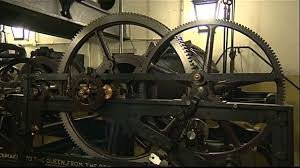 compensates for all external influences on the mechanism and is crucial in helping the clock keep accurate time. It’s adjusted using pre-decimal pennies, which regulate the clock mechanism; adding one penny causes the clock to gain two-fifths of a second in 24 hours. The clock is renowned for its precision and accuracy and is regarded as both the largest and most accurate four-faced chiming clock in the world. It still uses its original Victorian mechanism today to ring the bells however, a modern electric motor is used as a back-up in case the old mechanism ever fails.
compensates for all external influences on the mechanism and is crucial in helping the clock keep accurate time. It’s adjusted using pre-decimal pennies, which regulate the clock mechanism; adding one penny causes the clock to gain two-fifths of a second in 24 hours. The clock is renowned for its precision and accuracy and is regarded as both the largest and most accurate four-faced chiming clock in the world. It still uses its original Victorian mechanism today to ring the bells however, a modern electric motor is used as a back-up in case the old mechanism ever fails.
 compensates for all external influences on the mechanism and is crucial in helping the clock keep accurate time. It’s adjusted using pre-decimal pennies, which regulate the clock mechanism; adding one penny causes the clock to gain two-fifths of a second in 24 hours. The clock is renowned for its precision and accuracy and is regarded as both the largest and most accurate four-faced chiming clock in the world. It still uses its original Victorian mechanism today to ring the bells however, a modern electric motor is used as a back-up in case the old mechanism ever fails.
compensates for all external influences on the mechanism and is crucial in helping the clock keep accurate time. It’s adjusted using pre-decimal pennies, which regulate the clock mechanism; adding one penny causes the clock to gain two-fifths of a second in 24 hours. The clock is renowned for its precision and accuracy and is regarded as both the largest and most accurate four-faced chiming clock in the world. It still uses its original Victorian mechanism today to ring the bells however, a modern electric motor is used as a back-up in case the old mechanism ever fails.As we climbed the last few steps and opened the final door we entered the belfry and here before us was Big Ben, 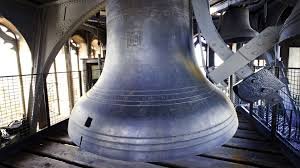 the most famous bell in the world. There is some dispute over who the bell was named after but we do know that it was cast by Warners of Stockton on Tees in 1856 however, in 1857, the bell cracked so a replacement was made which was 2.5 tons lighter and cast by George Mears at his Whitechapel Foundry. This bell was taken through the streets of London with much pomp and ceremony and hauled into position in the tower which was eventually completed in 1859. Two months after its first chime though, this bell also cracked so was taken out of commission; a smaller quarter bell chimed on the hour for four years until in 1863, it was decided that if the great bell was rotated a quarter of the way clockwise, an undamaged portion could then be struck with a smaller and lighter hammer which remains in place today. When struck, Big Ben makes the musical note of E however,
the most famous bell in the world. There is some dispute over who the bell was named after but we do know that it was cast by Warners of Stockton on Tees in 1856 however, in 1857, the bell cracked so a replacement was made which was 2.5 tons lighter and cast by George Mears at his Whitechapel Foundry. This bell was taken through the streets of London with much pomp and ceremony and hauled into position in the tower which was eventually completed in 1859. Two months after its first chime though, this bell also cracked so was taken out of commission; a smaller quarter bell chimed on the hour for four years until in 1863, it was decided that if the great bell was rotated a quarter of the way clockwise, an undamaged portion could then be struck with a smaller and lighter hammer which remains in place today. When struck, Big Ben makes the musical note of E however,  he is not alone in the belfry as there are in fact four other bells beneath him that ring on the ‘quarter’ hours and strike the notes G sharp, F sharp, E and B; together their notes all combine to form the famous tune and, like Big Ben, these bells are also fixed and struck by hammers from outside.
he is not alone in the belfry as there are in fact four other bells beneath him that ring on the ‘quarter’ hours and strike the notes G sharp, F sharp, E and B; together their notes all combine to form the famous tune and, like Big Ben, these bells are also fixed and struck by hammers from outside.
 the most famous bell in the world. There is some dispute over who the bell was named after but we do know that it was cast by Warners of Stockton on Tees in 1856 however, in 1857, the bell cracked so a replacement was made which was 2.5 tons lighter and cast by George Mears at his Whitechapel Foundry. This bell was taken through the streets of London with much pomp and ceremony and hauled into position in the tower which was eventually completed in 1859. Two months after its first chime though, this bell also cracked so was taken out of commission; a smaller quarter bell chimed on the hour for four years until in 1863, it was decided that if the great bell was rotated a quarter of the way clockwise, an undamaged portion could then be struck with a smaller and lighter hammer which remains in place today. When struck, Big Ben makes the musical note of E however,
the most famous bell in the world. There is some dispute over who the bell was named after but we do know that it was cast by Warners of Stockton on Tees in 1856 however, in 1857, the bell cracked so a replacement was made which was 2.5 tons lighter and cast by George Mears at his Whitechapel Foundry. This bell was taken through the streets of London with much pomp and ceremony and hauled into position in the tower which was eventually completed in 1859. Two months after its first chime though, this bell also cracked so was taken out of commission; a smaller quarter bell chimed on the hour for four years until in 1863, it was decided that if the great bell was rotated a quarter of the way clockwise, an undamaged portion could then be struck with a smaller and lighter hammer which remains in place today. When struck, Big Ben makes the musical note of E however,  he is not alone in the belfry as there are in fact four other bells beneath him that ring on the ‘quarter’ hours and strike the notes G sharp, F sharp, E and B; together their notes all combine to form the famous tune and, like Big Ben, these bells are also fixed and struck by hammers from outside.
he is not alone in the belfry as there are in fact four other bells beneath him that ring on the ‘quarter’ hours and strike the notes G sharp, F sharp, E and B; together their notes all combine to form the famous tune and, like Big Ben, these bells are also fixed and struck by hammers from outside.The amalgamation of Tim’s stunning photographic images and his natural storytelling ability gave us a fascinating insight into some of the inner secrets of the Elizabeth Tower and its contents as well as some intriguing background history on its designers and constructors.

Leave a Reply
You must be logged in to post a comment.